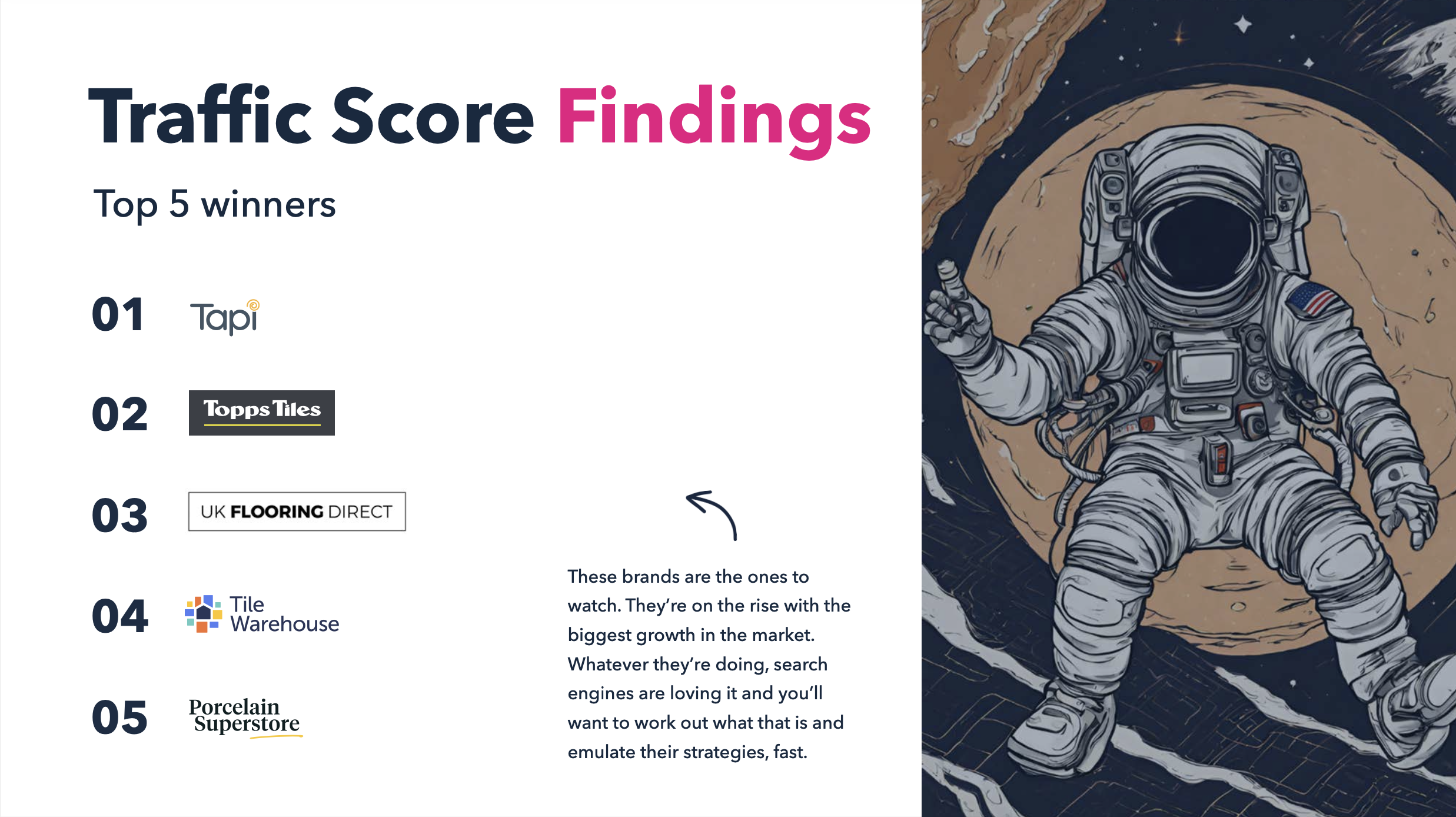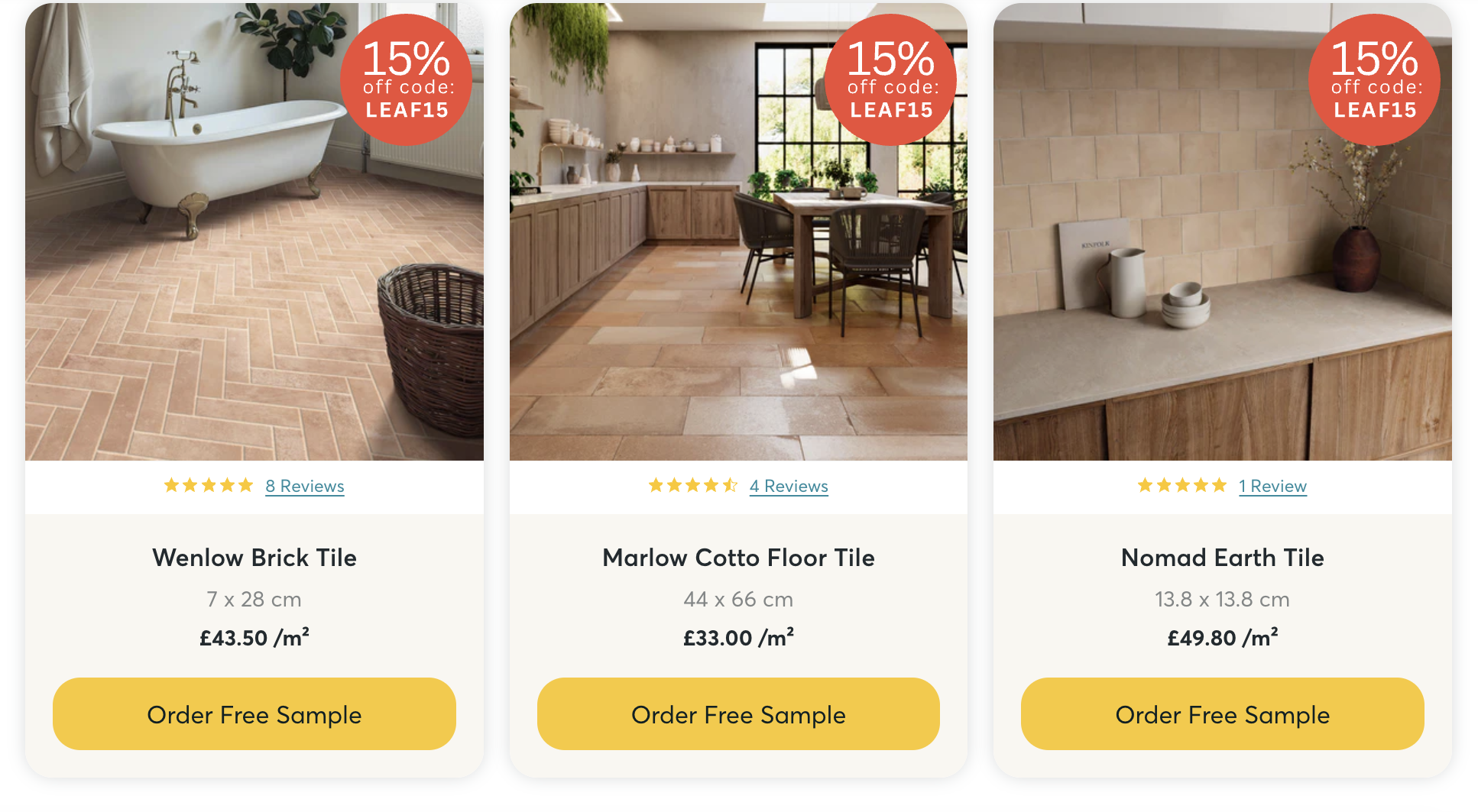When Samples Become Sales
Porcelain Superstore – a family‑run tile specialist – more than doubled its organic traffic score year on year, jumping by 224%. That’s not a typo. I spoke about them six months ago, and that continues. They’re picking up search share while rivals are going backwards.
This isn’t about textbook SEO, it’s about rethinking how users buy tactile products online.
Instead of focusing purely on rankings, Porcelain Superstore has taken the friction out of the sample‑to‑purchase journey. The following analysis digs into the tiles market, extracts the data from our report and then explores Porcelain Superstore’s site to understand why they’re winning. If you sell products that customers want to see, touch or try before committing, you’ll find lessons you can adopt immediately.– a sector built on samples
Tiles sit in the wider home‑improvement and flooring market, which combines high purchase values with long decision cycles. People don’t retile their bathroom on a whim. They research styles, colours, and finishes, order samples, mull over options, and then commit. Hundreds of retailers jostle for visibility, and only a handful gain ground. Our tile industry report ranks the top 100 brands by their organic traffic score, an Ahrefs‑derived metric estimating how much traffic each site attracts based on keyword rankings, search volumes, and click‑through rates. It’s not a GA figure, but it allows relative comparison across domains.
The last six months saw winners and losers. Established names moved in opposite directions: Topps Tiles grew 68% while Online Carpets fell 37%; challengers such as Flooring Superstore and Tile Warehouse gained 9% and 55% respectively. The biggest surprise is Porcelain Superstore. From a modest position outside the top ten, it rocketed up thirty‑two places to rank 14th. It’s now outperforming many chains with physical showrooms and deep pockets.

What explains this? Part of the answer lies in how brands handle the sample process. Tiles, like carpets or engineered wood, are tactile. Customers want to feel texture, judge colour in their own light and test quality.
Traditional retailers treat samples as an afterthought. A checkbox on the product page or an upsell at checkout. But as online competition intensifies, the sample experience becomes the main differentiator. Brands that make it effortless to order, receive and use samples convert more browsers into buyers. Porcelain Superstore has understood this better than anyone.
Almost every category and product page features clear calls to “Order Free Samples”, and the messaging throughout the site encourages customers to try before they buy. Testimonials on the homepage praise the speed and generosity of sample packs: one customer notes that they received a whole tile sample rather than a half tile.

Another mentions that samples were delivered quickly and free of charge. By treating samples as a core service rather than an add‑on, the brand addresses the biggest barrier to buying tiles online – uncertainty about look and feel. The ordering process itself is well executed. Product pages display a prominent “Free Sample” button alongside price and availability, with no requirement to create an account.
Users can add multiple samples to a dedicated sample basket and check out with a simple form. Delivery information is upfront, and there’s no hidden postage fee. Once a sample is ordered, the follow‑up emails include inspirational images and links to related products, subtly nudging users back to the site.
This journey – from browsing to sample request to purchase – feels as easy as ordering groceries (maybe even easier).
Editorial expertise and long‑tail authority
Porcelain Superstore also invests heavily in content that answers searchers’ questions. The Ideas Hub houses guides on trends like “green bathroom tiles” and “terracotta floor tiles”, topics that align with emerging search volumes identified in Salience’s keyword trends data.
Each article blends design inspiration with practical advice and links directly to relevant product categories. This internal linking strategy helps search engines understand topic clusters while guiding users deeper into the site. The copy avoids keyword stuffing and reads like an interiors magazine – something many DIY competitors fail to achieve.
Furthermore, the site structures navigation around user intent. Instead of generic categories, the main menu offers options like Shop By Colour, Shop By Style and Shop By Shape & Size.
This anticipates the way customers search (“green bathroom tiles”, “hexagon tiles”) and mirrors emerging product trends. Each filter reduces the range logically and surfaces relevant advice.
The brand’s domain authority isn’t top of the market, yet by aligning content with searcher intent and providing a superior experience, they’ve earned links from design blogs and magazines – amplifying their visibility.
Numbers – quantifying the outperformance
Our traffic‑score table shows Porcelain Superstore achieving 54 653 estimated visits in May 2025, up from 16 890 six months earlier.
Generic terms such as “floor tiles” and “bathroom floor tiles” are declining. By focusing on a) rising trends and b) higher intent, longer tail queries rather than chasing saturated keywords, Porcelain Superstore captures incremental demand. This data‑driven approach shows an understanding of how search intent evolves.
User journey funnel
Understanding the path from search to purchase in a tactile category is crucial. The diagram below visualises the typical user journey for tile shoppers, highlighting where Porcelain Superstore excels.
Notice how the brand emphasises the Free Samples step. This widens the funnel by keeping shoppers engaged and builds trust before the purchase stage.
Key takeaways for marketers
- Treat samples as a conversion tool, not a cost centre – Offering free, full‑size samples and promoting them prominently removes the biggest barrier to buying tactile goods online. Make the sample journey seamless and follow up with helpful content. Porcelain Superstore proves this pays off.
- Design your navigation around user intent – Replace generic categories with filters that mirror how people search (colour, style, size). This helps users find what they need quickly and signals topical relevance to search engines.
- Invest in editorial depth rather than keyword stuffing – Write articles that genuinely answer questions and inspire customers. Link them logically to product categories. High‑quality content attracts links and reinforces expertise.
- Prioritise emerging trends over saturated terms – Use tools to identify rising searches in your sector. Create dedicated pages and content clusters early. Porcelain Superstore’s focus on terracotta and acoustic panelling captured growing demand.
- Provide a polished, mobile‑friendly experience – Fast load times, clear headings and frictionless checkout build trust and reduce abandonment. Simple design choices can have more impact than chasing algorithm loopholes.
Conclusion
In a market where overall organic visibility is slipping, Porcelain Superstore has achieved triple‑digit growth by doing the basics differently. They’ve embraced the sample‑to‑purchase journey, structured their site around how people actually search and created content that educates rather than manipulates. The result is a steady stream of organic traffic growth and a reputation that extends beyond search. For marketers in other tactile industries – from carpets to wallpaper or even luxury fashion – the lessons are clear: take user intent seriously, make trying your product effortless and invest in genuine expertise. That’s how you turn browsers into buyers and outrun competitors still clinging to old playbooks.
What’s Next?
Explore the full tile industry landscape
This case study draws from our comprehensive Tile Industry Report, which ranks all 100 brands by organic performance and reveals the market shifts reshaping the sector. Download the full report to see where your brand stands.
Transform your own sample-to-sale journey
Porcelain Superstore’s success proves that tactical CRO improvements drive real growth. Our CRO & UX services help brands like yours remove friction, boost conversions and turn browsers into buyers – whether you sell tiles, flooring or any product customers want to experience first.
See how UK Flooring Direct does it too
Porcelain Superstore isn’t alone in mastering the sample-to-sale journey. Read our analysis of how UK Flooring Direct turns free samples into customers and discover the conversion tactics that work across the wider flooring market.
Set us a challenge!
Most content marketing feels like shouting into the void because it serves algorithms, not humans. You publish consistently but see little commercial impact. Traffic stays flat while competitors dominate the conversations that matter.
We build content ecosystems that establish you as the definitive authority in your space. We’ve helped clients like Dreams pivot from mattress sellers into trusted category leaders. Ready to build content that actually builds your business?

